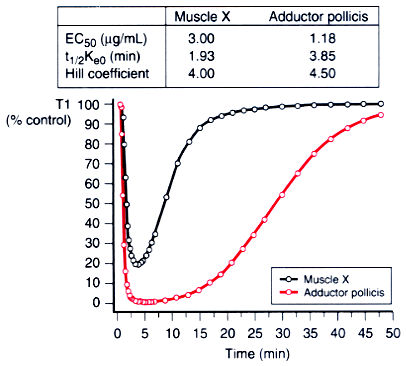 |
 |
Figure 13-20
A computer simulation based on Sheiner and colleagues'
model[224]
and data reported by Wierda et al.[285]
The ED95
of rocuronium at the adductor pollicis from this model is 0.33
mg/kg. Rocuronium, 0.45 mg/kg, is given as a bolus at time zero. Muscle X represents
a muscle (such as the diaphragm or the laryngeal adductors) that is less sensitive
to the effects of nondepolarizing relaxants than the adductor pollicis is but has
greater blood flow. In this example, the concentration of rocuronium producing a
50% block (EC50
) of muscle X is 2.5 times that of the adductor pollicis,
but the half-life of transport between plasma and the effect compartment (t½
ke0
)
of muscle X is only half as long. The rapid equilibration between concentrations
of rocuronium in plasma and muscle X results in a more rapid onset of blockade of
muscle X than the adductor pollicis. The greater EC50
at muscle X explains
the faster recovery of this muscle from neuromuscular blockade than the adductor
pollicis. Lower blood concentrations of rocuronium must be achieved at the adductor
pollicis than at muscle X before recovery begins. (Redrawn from Naguib M,
Kopman AF: Low dose rocuronium for tracheal intubation. Middle East J Anesthesiol
17:193–204, 2003.)

 |
